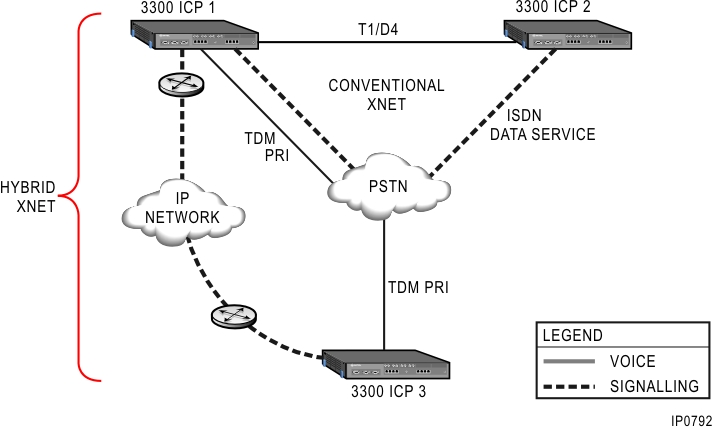
IP Networking allows IP and non-IP devices to connect over an IP network. With IP Networking, users have access to enhanced features such as conference and callback and administrators can build networks with centralized resources such as attendants and voice mail.
Compression can be used in conjunction with IP Networking.
XNET offers proprietary switched private network traffic (MSDN/DPNSS) networking over the Public Switched Telephone Network (PSTN). With XNET, users can make DPNSS calls on non-DPNSS trunks. Unlike the current implementation of DPNSS, you do not require an entire T1/E1 link between two systems.
XNET combines DPNSS calls with regular PSTN calls by separating voice and signaling channels and transmitting them as independent elements. Trunks carry the voice or data components of the call and switch them over the public network. Fixed connections between nodes are not necessary.
With regular XNET, the voice trunk can be any DID-capable trunk (PRI, T1/D4, analog DID, DASSII DDI). Signaling is delivered as D-channel over ISDN PRI B-channel trunks using HDLC (High level Data Link Control) data link controllers at each end. ISDN 56K or 64K data service must be available for the PRI trunks that carry the signal channels.
Hybrid XNET carries voice on any DID-capable TDM trunk (ISDN-PRI, Digital E&M, T1/D4, R2, Analog DID) just like regular XNET, but uses the IP network to perform the call setup, feature invocation, and tear down signalling.
The following trunk combinations are supported by Mitel:
|
|
Hybrid XNET |
XNET |
|
Network Signaling |
IP |
ISDN |
|
Voice Media |
TDM |
TDM |
All XNET calls between a pair of systems share the same signaling link. When making concurrent XNET calls to different remote systems, each remote system requires its own signaling link. Signaling calls are established on a demand basis and torn down according to the amount of time programmed in the ICP/PBX Networking form. This removes the predetermined relationship of signaling channel and fixed end-to-end mapping of voice channels.
Synchronization of XNET calls (voice and signaling elements) is based on unique DID/DDI PSTN numbers. Each system must have a list of DID numbers programmed in its database for every other system in the network to which it can make XNET calls. The voice and signaling calls are made concurrently.

This diagram shows the use of both regular and hybrid XNET within the same network of three, remotely situated nodes. In both cases, signalling is carried primarily by the IP network using MSDN for call setup, feature invocation, and tear down. Once call set up is established, audio is streamed over the PSTN using TDM PRI or over the IP network using VoIP.
Both virtual and real DPNSS calls are supported. Virtual DPNSS calls consist solely of signaling such as Busy Lamp Field (BLF), call back requesting, and remote third-party call forward setup. One ISDN PRI trunk is required for the signaling call between a pair of systems. Real DPNSS calls require an additional voice trunk for each call, to transmit the voice element of the call.
The number of concurrent XNET calls between a pair of systems is limited by a maximum of 200 calls (real and virtual combined) and the number of physical trunks available. If the same trunks are shared for use in regular PSTN calls, then only the trunks not being used are available to XNET. If a single PRI T1 link is used to support XNET between a pair of systems, the maximum number of concurrent real calls is 22 for the DS1/Dual T1 card or 29 for the CEPT/Dual E1 card (one of the B-channels is used for the XNET signaling element of the call). Existing DPNSS related alarms, logs, and statistics are supported in the XNET configuration. Dynamic sharing of bandwidth is supported by using XNET trunk group arrangements.
To the end-user, XNET acts the same as leased-line DPNSS, but the point-to-point characteristics of leased lines are replaced with the capabilities of the switched network. XNET can be used for the entire system, or only used between some nodes while standard DPNSS is used between others. This allows the customer to make calls that can be routed using either method. For example, if XNET is used between system A and system B and standard DPNSS is used between system B and system C then a call from system A to system C might be routed to system B using XNET and then to system C using standard DPNSS.
IP Networking and XNET can be used concurrently on the system.
See IP Networking/XNET Planning for programming conditions.
None
